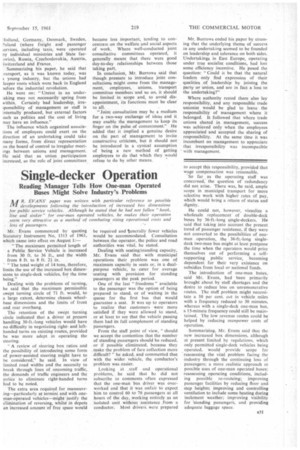Single-decker Operation
Page 65

If you've noticed an error in this article please click here to report it so we can fix it.
Reading Manager Tells How One-man Operated Buses Might Solve Industry's .Problems
MR. EVANS paper was written with particular reference to possible developments following the introduction of increased box dimensions for public service vehicles. Although he stated that he had not fallen "hook, line and sinker" for one-man operated vehicles, he makes their operation seem very attractive as a method of combating rising operational costs and loss of passengers.
Mr. Evans commenced by quoting Statutory Instrument No, 1313 of 1961, which came into effect on August 1:— " The maximum permitted length of a Public Service Vehicle is increased from 30 ft. to 36 ft., and the width from 8 ft. to 8 ft. 21 'The total weight of 14 tons, therefore, limits the use of the increased box dimensions to single-deck vehicles, for the time being."
Dealing with the problems of turning, he said that the maximum permissible swept turning circle of 71 ft. would, to a large extent, determine chassis wheelbase dimensions and the limits of front and rear overhang.
The retention of the swept turning circle indicated that a driver at present handling 30-ft.-long vehicles would have no difficulty in negotiating rightand lefthanded turns on existing routes, provided he was more adept in operating the steering.
" A review of steering box ratios and the possibility of introducing some form of power-assisted steering might have to be considered," he said. In view of limited road widths and the necessity to break through lines of oncoming traffic, the demands of traffic engineers and the police to eliminate right-handed turns had to be noted.
The extra area required for manceuvring—particularly at termini and with oneMan-operated vehicles—might justify the elimination Of reversing, whilst in depots an increased amount of free space would be required and tenerally fewer vehicles would be accommodated. Consultation between the operator, the police and road authorities was vital, he stated.
Dealing with seating/standing capacity, Mr. Evans said that with municipal operations their problem was one of maximum capacity in seats or, in a dualpurpose vehicle, to cater for average seating with provision for standing passengers at the peak period.
One of the last " freedoms " available to the passenger was the option of being prepared to stand. or of waiting in the queue for the first bus that would guarantee a seat. it was up to operators to realize that customers were more satisfied if they were allowed to stand, or at least to see that the vehicle passing them had its full complement of standing passengers.
From the staff point of view, "should we accept the contention that the number of standing passengers should be reduced, or if possible eliminated, because they make the problem of fare collection more difficult?" he asked, and commented that with the wider vehicle, the conductor's problem was•easier.
Looking at staff and operational problems, he said that he did not subscribe to comments often expressed that the one-man bus driver was overworked and that it was unfair to expect him to control 60 to 70 passengers at all hours of the day, working entirely as an isolated unit without assistance .from a conductor. Most drivers were prepared to accept this responsibility, provided that wage compensation was reasonable.
'So far as the operating staff was concerned, the question of redundancy did not arise. There was, he said, ample scope in municipal transport for more selective work with higher rates of pay, which would bring a return of status and dignity.
He could not, however, visualize a wholesale replacement of double-deck buses by 36-ft.-long single-deckers. He said that taking into account the present trend of passenger resistance, if they were not converted to the possibilities of oneman operation, the 36-ft.-long singledeck two-man bus might at least postpone the time when the operators would price themselves out of performing a selfsupporting public service, becoming dependent for their very existence on subsidies from local or national funds.
The introduction of one-man buses, said Mr. Evans, had been primarily brought about by staff shortages and the desire to reduce loss on unremunerative routes. The staff problem might necessitate a 50 per cent, cut in vehicle miles with a frequency reduced to 30 minutes, whereas with a single-deck one-man bus, a 15-minute frequency could still be maintained. The low revenue routes could be helped by reducing manpower costs of operation.
Summarizing, Mr. Evans said that the new increased box dimensions, although at present limited by regulations, which only permitted single-deck vehicles being operated, would provide scope for reassessing the vital problem facing the • industry through the continuing loss of passengers; a more realistic approach to possible uses of one-man operated buses; reassessing operating conditions, including possible re-routeing; improving passenger facilities by reducing floor and step heights; improving and controlling ventilation to include some heating during inclement weather; improving visibility for *standing passengers, and providing adequate luggage space.




































































































































